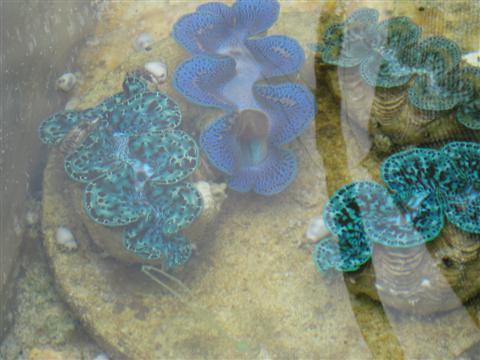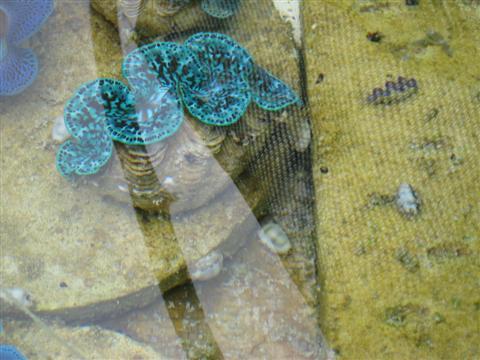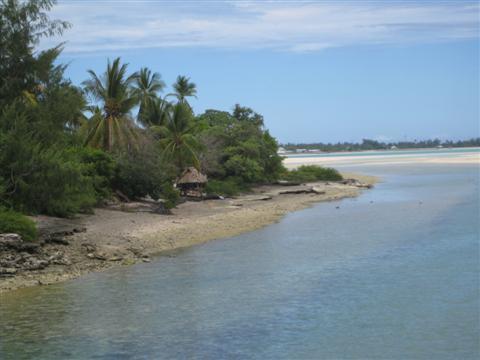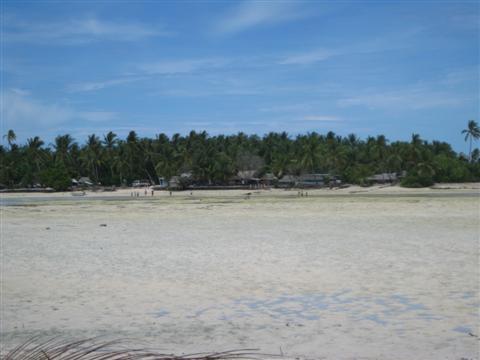Clam chowder. Clam bake. Clam up. Tight as a clam. As happy as a clam. OK, but you don't normally associate the filter-feeding, plankton-feasting bivalve mollusc -- you probably won't use that term either -- with gems. Oysters, yes, but clams?
Yet the clam's mantle, the fleshy outer layer that secretes its shell, proffers such a mesmerisingly iridescent swirl of velvety phosphorescent hues from amethyst violet and purple through sapphire blue and turquoise to emerald and jade green that you could be forgiven for thinking that you are prying into a miniature Aladdin's cave. Provided the clam is open, that is.
Clam 'jewels' at Kiribati farm
In the tiny Equator-straddling Pacific archipelago of Kiribati, over a broken bridge at the eastern end of South Tarawa atoll, wading across a sea channel between two islets to North Tarawa -- a ferry will take you at high tide -- you'll come to a clam farm run by an Australian for the home aquarium export market.
Not far from a three-cottage home-stay in the palm-fringed not-even-hamlet of Abatao, a myriad tiny clams virtually invisible to the human eye are cultivated in tanks. When you can just about see them they are shipped to local villages to be further cultivated to full size in cages in the sea. For this the villagers are paid $2 per clam in an effort to stimulate jobs and erode chronic unemployment in Kiribati.
These are not your giant clams that can measure four feet across and weigh up to 450 pounds. When they are fully grown they fit into the palm of your hand. Their mantles are an incredible kaleidoscope of electric hues that will dazzle in any home aquarium and bring a little of the warmth of the tropical seas to the more frigid drawing rooms further to the north or south.
Another clam gem
Over 6,000 miles to the west, in the Australian Indian Ocean territory of the Cocos Islands, John Clunies-Ross, scion of the Scottish family that once ruled them as kings before Australia bought them out in 1978, is busy pottering around his clam farm assessing the damage wrought by the worst deluge ever recorded here -- 850 millimeters, nearly three feet, in a little over 48 hours, eight times the average for this time of year.
A sturdy middle-aged man with tight curly hair, who drives around West Island in a van painted like a tiger, he is trying to repair the extensive pump system which was badly damaged when a tree uprooted by the storm crashed down on a water intake pipe.
John's great-great-great-grandfather, also John, brought in Malays to the then uninhabited islands to work a profitable copra business from the abundant palm trees. Queen Victoria granted the islands to the Clunies-Ross family in perpetuity, and John and his descendants bore the titles of Ross I to Ross V, the current John's father, ruling the tiny archipelago under the overall British empire represented by the governor of Singapore colony.
A half hour across the blue-green lagoon from West Island, in a tidy settlement on Home Island, in neat rows of houses with several mosques, the 600 or so descendants of the imported Malays live a traditional life tinged by modernity. Their women-folk wear nun-like head coverings but drive around on their errands in electric golf carts.
A little museum relates the Cocos' role in World War II when the Japanese bombarded it from the sea and air and thousands of British troop were stationed here. But it basically tells the history of Clunies-Ross rule, when they issued plastic tokens and signed chits of paper for money of up to five rupees, as well as commemorative gold coins with their faces on.
On a promontory amid palm trees a few hundred yards beyond the settlement is the kings' palace, Oceania House, a Victorian-style mansion with eaves, colonnades and bays built in 1888 that welcomed Queen Elizabeth II on a visit in 1954.
Near the Tabon Te Keekee Homestay at Abatao, Kiribati
Some say the Clunies-Rosses treated their Malay workers with seigneurial haughtiness. Australia, which took up overall sovereignty from Singapore when the latter ceased to be a British colony in 1955, slammed conditions here as slavery, bought out the Clunies-Ross interests in 1978, forced the family's shipping company into bankruptcy by boycotting it, and took over Oceania House as payment in 1986.
In a UN referendum in 1984 the 500-odd islanders voted for integration with Australia rather than independence. But Aussie expats here here say the Clunies-Rosses were benevolent patriarchs and treated the islanders much better than Australia treated its own Aborigines at the time. They say there was a lot of Aussie hypocrisy involved and Aussie outsiders were stirring up the locals.
More Kiribati clams
Be that as it may, on West Island the dynasty's latest scion seems quite concerned by the damage done to his clam farm as he starts up the pump engine again. Some of his specimens seem larger than those in Abatao, up to a foot or more long.
Of course I have no photos of these. For those of you who might have missed a previous blog, I managed to erase an entire memory stick when trying to remove one blurred photo of a Tasmanian devil playing nasty.
And yet some more from Kiribati
But looking into John's tanks with mature clams is indeed, as in Abatao, to peer into an underwater Aladdin's cave filled with velvety fluorescent gems.
By the same author: Swimming With Fidel: The Toils Of An Accidental Journalist, available for Kindle, with excerpts available at: http://www.amazon.com/dp/B00IMNWV2W







